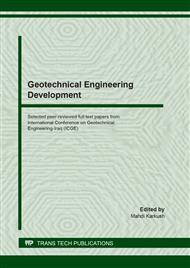p.153
p.162
p.169
p.179
p.188
p.195
p.203
p.212
p.221
Effect of Wetting-Drying Cycles on Desiccation Crack Pattern and Soil Behavior
Abstract:
Cracking, shrinkage, and curling of soils, in general, take place due to drying. These deformations lead to many problems include the development of main paths for water flow and pollutant transport, reduction of soil strength (and impact on other mechanical properties of soils), erosion in slopes, landslides, increase infiltration capacity of the soil and the differential settlement problems. Few studies have investigated the effect of wetting-drying (W-D) cycles on desiccation cracks of soils. The effect of multiple wetting-drying cycles in the cracking behavior was investigated in this research by performing several wetting-drying (W-D) cycles on the initially saturated samples (of pure kaolinite and a mixture of kaolinite with bentonite) under the lab atmosphere (24 ± 1 °C, and 52 ± 2% of RH). The weight of each sample was monitored using a computerized scale (with an accuracy of 0.01 g) connected to the computer. During the test, the water evaporation path with the development of surface cracks and volume shrinkage was monitored by means of digital images. It was observed that the crack patterns changed during the initial cycles, but there was an equilibrium state in the third and fourth W-D cycles. Additionally, it was observed that the main cracks formed in the first dry path were virtually closed after 10 minutes of the second wetting path; in the meantime, small cracks (fissures) were initiated after this wetting process. It was, also, detected that soils with high plasticity required more W-D cycles to reach the equilibrium condition than soils with low plasticity. The results of these experiments are useful for understanding the effect of different seasons on soil behavior.
Info:
Periodical:
Pages:
188-194
Citation:
Online since:
August 2020
Authors:
Price:
Сopyright:
© 2020 Trans Tech Publications Ltd. All Rights Reserved
Share:
Citation:


